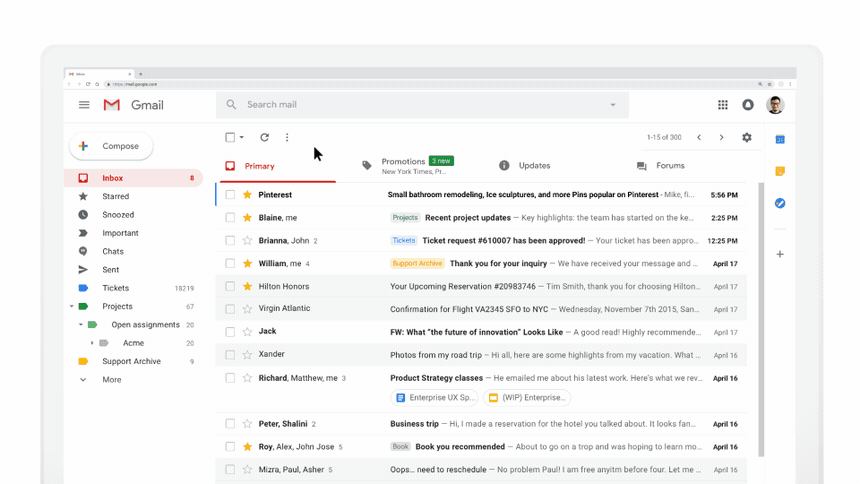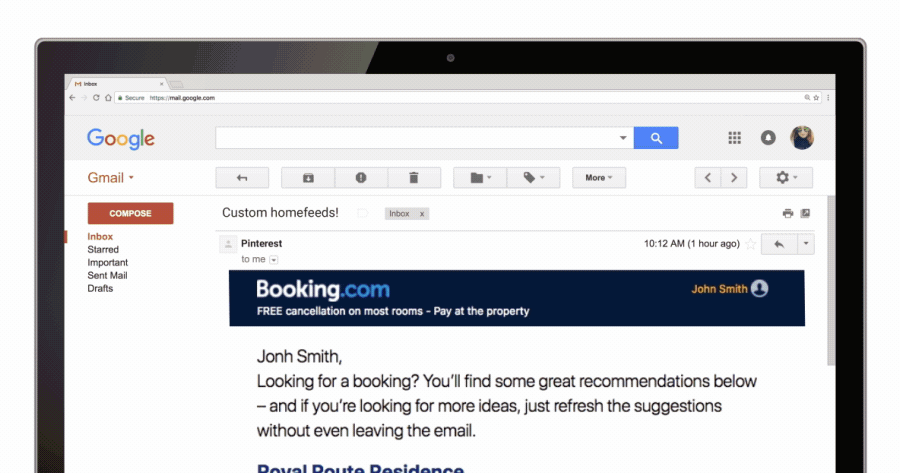Best practices, Dobre praktyki
Best practices, Dobre praktyki
It would seem that when it comes to mailboxes, nothing can change or surprise us anymore. However, this is a very misleading statement. The email has been evolving for many years, continuing to introduce innovations and a range of benefits for its users.
Some time ago, there was another innovation from Google, which announced the implementation of AMP for email – delivering a fast-loading, and mobile-friendly email environment.
The emergence of AMP has started a major revolution in email, which opens up many possibilities for marketers. Officially, this option has been available to all Gmail users since 2018 but it is still not very popular and not everyone has heard of it. It’s worth considering how this technology will affect our mailboxes over time and, more importantly, how it will change the way they function.
AMP (Accelerated Mobile Pages), is an open source development technology, allowing any web developer to make original modifications and improvements to it. It allows fast rendering of web pages with static content, and the implementation itself allows the content of the web page to be adapted to the technical parameters of the device on which it is displayed.
The introduction of this solution in mailboxes has a significant impact on the design of more interactive messages, as well as the delivery of more valuable content to receivers.
AMP allows email to be better scaled and presented in a completely new way and thus provides freedom to users. Emails containing AMP components will resemble a web page, which can be viewed immediately in the inbox. In practice, this means, for example, that a form can be filled out directly in the email, without having to go to the website.
As an example, Google shows the Pinterest newsletter:

Source: medium.com
As can be seen in the example above, the user can view recommended content from Pinterest directly in Gmail and also pin it to their board.
Emails are becoming more interactive and therefore allow for even more effective and engaging communication with the customer. As in the example mentioned above, we can tailor content according to our recipient’s preferences that will interest and inspire them to take action – in this case, to pin a graphic to their Pinterest board.
Here are selected examples of how this new technology can be adapted to email.
As an example of the use of AMP, we can point out websites such as Booking.com which allow the addition of booked hotels and travel dates to Google Calendar. The relevant components will enable us to set up a reminder to ensure that we do not miss an appointment. All of this can be done in a few clicks directly from the email.

Source: mobirank.pl
Suppose, for example, that someone wants to schedule a meeting with you, but can’t see your calendar, so sends an email to find out the dates and times you are available. In the email, there is a form to coordinate the details. With AMP for email, you can respond interactively through the form, without having to click a link and be redirected to another page.
AMP for email can also help you do more in less time, allowing you to quickly attend events, view and interact with auctions and campaigns or complete a survey without leaving your mailbox.
Email phishing, which has been popular in recent years, can, unfortunately, be a barrier to taking full advantage of the technology in the mailbox. Gmail will require companies to have a good reputation and authenticate senders with SPF, DKIM, and DMARC. However, will this be enough?
We see a lot of potential in this technology, but its use and value will be able to be verified by time and successive tests.
Do you have questions? Contact our BOK.
We are proud to announce that Vercom S.A., the company behind the EmailLabs project, successfully passed an audit for compliance with the latest ISO/IEC 27001:2022 and ISO/IEC 27018:2019 standards....
Gmail has announced significant changes in the requirements for email senders to maintain a good reputation and proper classification of messages in user inboxes starting from February 1, 2024....
The increasing number of phishing attacks each year, and the projection that this trend will continue to escalate, aren’t likely to astonish anyone. This can be attributed, in part,...
Out of all the things that can go wrong when sending out marketing emails, having your emails end up in the recipient’s spam folder is arguably the most dreaded...
Email Authentication, Security
DMARC is an email authentication protocol that is designed to give domain owners the ability to protect their domain from unauthorized use, commonly known as email spoofing. Spoofing occurs...
With the emergence of the Covid-19 pandemic, many brands have been challenged to adapt in a short period to the changed reality and new consumer attitudes. That meant reorganizing...
Are you frustrated with the constant struggle of your emails getting blocked by Gmail? Have you ever wondered about the reasons behind this issue and, more importantly, how to...
In the ever-evolving landscape of email management, Google has announced an exciting upgrade to Gmail’s summary cards, aimed at improving user experience and streamlining inbox navigation. The latest enhancements,...
Antispam, Best practices, Dobre praktyki
Entering the world of email communication, you’ll encounter many terms that initially seem straightforward and intuitive. However, some of these can be pretty challenging. Accurately distinguishing between them is...
Are you frustrated with the constant struggle of your emails getting blocked by Gmail? Have you ever wondered about the reasons behind this issue and, more importantly, how to...
In the ever-evolving landscape of email management, Google has announced an exciting upgrade to Gmail’s summary cards, aimed at improving user experience and streamlining inbox navigation. The latest enhancements,...
Antispam, Best practices, Dobre praktyki
Entering the world of email communication, you’ll encounter many terms that initially seem straightforward and intuitive. However, some of these can be pretty challenging. Accurately distinguishing between them is...
Attaching a folder to an email may seem complicated at first glance, especially if you’re trying to send multiple files or an entire project’s documents to a colleague or...
Best practices, Deliverability
In today’s digital age, email has become an integral part of our personal and professional communication. We rely heavily on emails to send important messages, documents, and updates. But...
We are proud to announce that Vercom S.A., the company behind the EmailLabs project, successfully passed an audit for compliance with the latest ISO/IEC 27001:2022 and ISO/IEC 27018:2019 standards....
Best practices, Deliverability
Are you struggling to improve the deliverability and engagement of your email marketing campaigns? Look no further than email subdomains. You can protect your root domain and effectively manage...
What is the darknet? Shrouded in mystery for many years and often associated with ominous connotations, the darknet is a part of the internet that evokes curiosity, fascination, and...
A few weeks ago, at Vercom, we began the process of implementing the NIS2 Directive and preparing to meet the requirements of the Digital Operational Resilience Act (DORA). What...